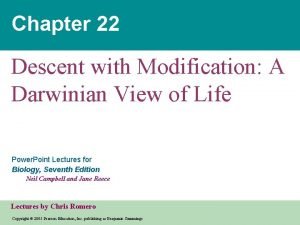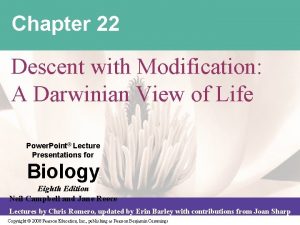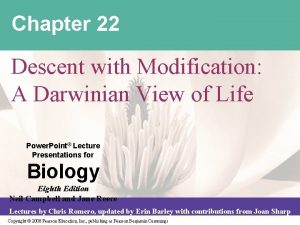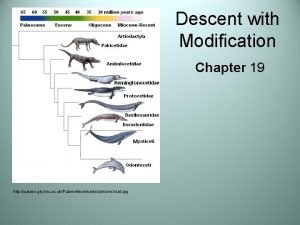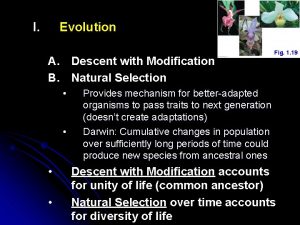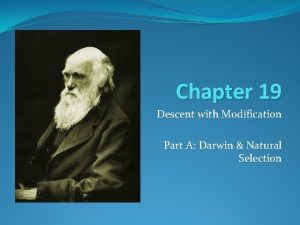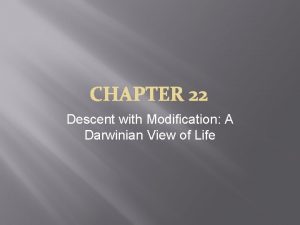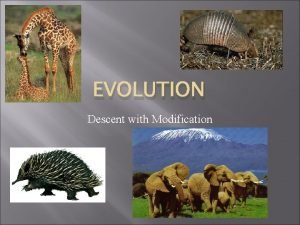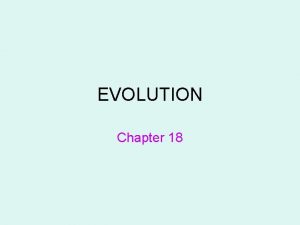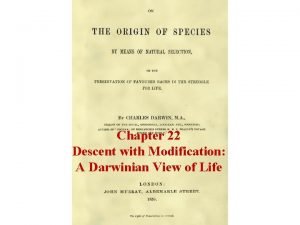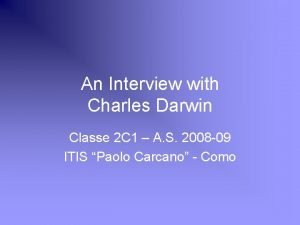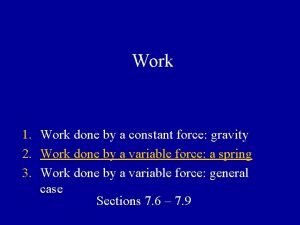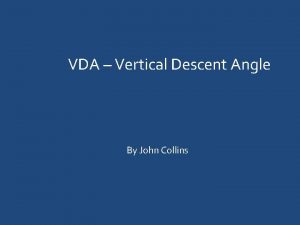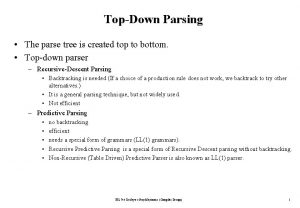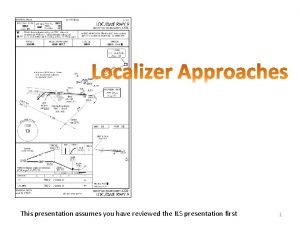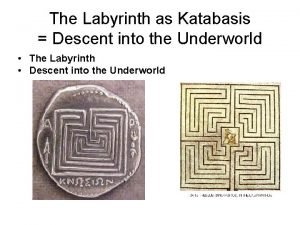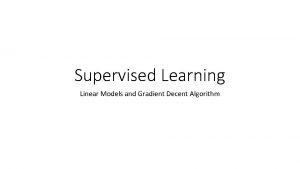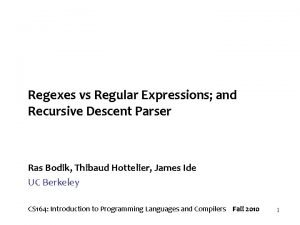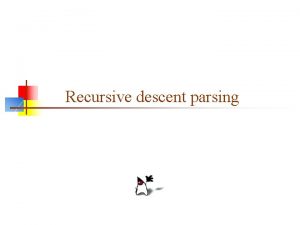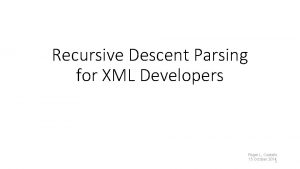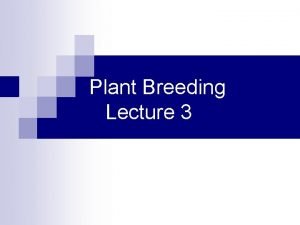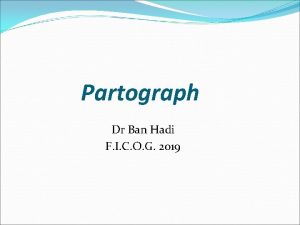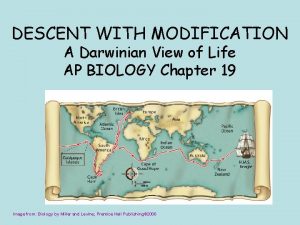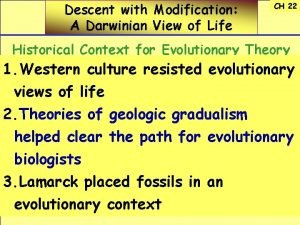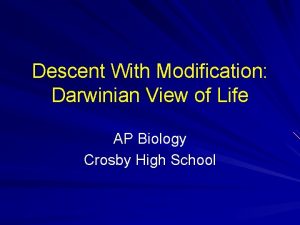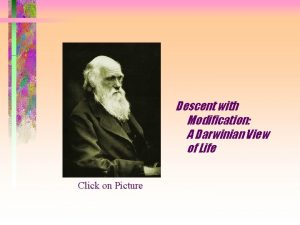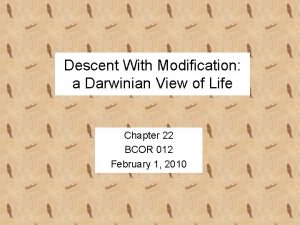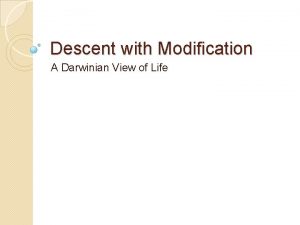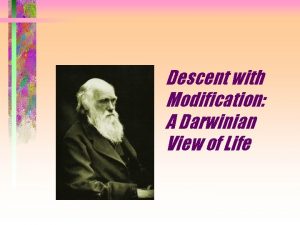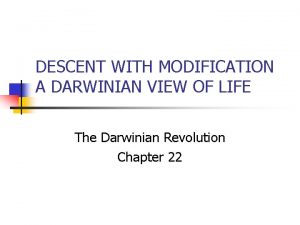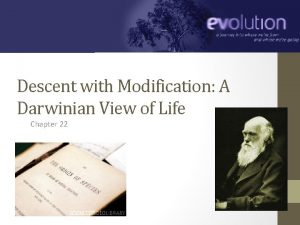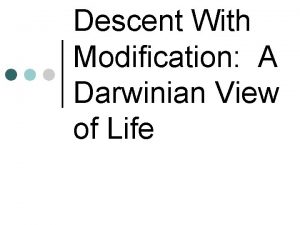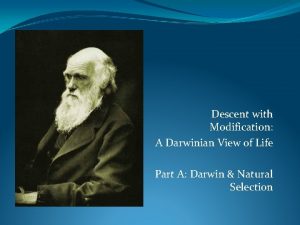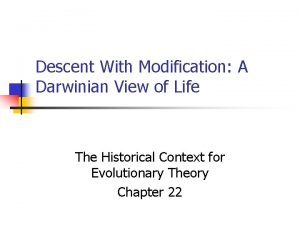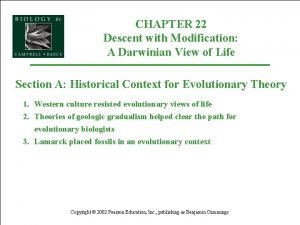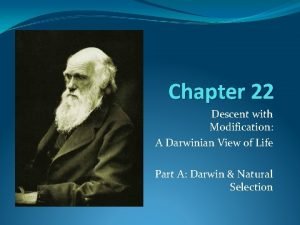Descent With Modification a Darwinian View of Life





























- Slides: 29

Descent With Modification: a Darwinian View of Life Chapter 16 Botany 4 April 17, 2007

Darwin’s ideas challenged the prevailing view that the world was only a few thousand years old and that each kind of organism had been created individually in six days.

In 1645 Bishop Ussher of Ireland stated that the Earth must have been created on October 26 th 4004 BC.

On the Shoulders of Giants Scientists Who Influenced Darwin

JAMES HUTTON 1726 -1797 Geologist, chemist, naturalist, father of modern geology� GRADUALISM Hadrian was concerned to consolidate his boundaries. He visited Britain in 122 AD, and ordered a wall to be built between the Solway Firth in the West and the River Tyne in Hadrian’s the eastwall "to separate Romans from Barbarians".

Charles Lyell, 1797 -1875 UNIFORMATARIANISM

Georges Cuvier (1769 -1832) early recognized the phenomena of restriction of distinctive fossils — guide fossils — to particular zones, formations, or series and applied this tool in his stratigraphical studies. Moreover, he observed a pattern in the change from level to level. Of the shells found in the upper, more recent levels, he states that the "eye of the most expert naturalist cannot distinguish from those which at present inhabit the ocean. " Forms of life recovered from successively more ancient strata were observed to become progressively more strange and "peculiar" (Cuvier 1817: 13, 108 -109).

"Do we not therefore perceive that by the action of the laws of organization. . . nature has in favorable times, places, and climates multiplied her first germs of animality, given place to developments of their organizations, . . . and increased and diversified their organs? Then. . . aided by much time and by a slow but constant diversity of circumstances, she has gradually brought about in this respect the state of things which we now observe. How grand is this consideration, and especially how remote is it from all that is generally thought on this subject!" Jean Baptiste Lamarck 1744 -1829 Text of a lecture given by Lamarck at the Musée National d'Histoire Naturelle, Paris, May 1803

Charles Darwin, 1809 -1882

Henslow’s sparrow Reverend John Henslow, 1796 - 1861 clergyman and naturalist

Robert Fitz. Roy, Captain of the H. M. S. Beagle

The Voyage of the H. M. S. Beagle 1831 -1836



Blue-black Grassquit

Darwin’s Beagle Voyage Observations: • Geographic regions have distinctive floras and faunas • Islands are centers of endemism • Organisms are tightly adapted to the conditions under which they live

Charles Darwin in 1840

Alfred Russell Wallace 1823 -1913

Darwin in 1859

Five premises underlying Darwin’s theory: • Variability: Populations of organisms are variable • Heritability: Some of the variable traits are passed from generation to generation • Overproduction: More individuals are produced in a population than will survive to reproduce • Competition: Individuals compete for limited resources

Five premises underlying Darwin’s theory: • Differential Survival: Those individuals better suited to their environment will leave more descendents than less well suited individuals. This is natural selection!

Evidence Supporting Darwin’s Views. . .

Homology The equivalency of structures serving quite different functions provides evidence of common ancestry.

The evolutionary and biogeographic relationships of species on island archipelagos provide evidence of evolution

Under artificial selection, a whole array of common vegetables was derived from a single species of wild mustard.

… and an entire array of dogs were bred from a wolf-like common ancestor.

Darwin reasoned that if, under artificial selection, so much change could be produced in a relatively short time, than what a great amount of change should be possible over hundreds of thousands of generations!

Two main features of the Darwinian view of life: • The diverse forms of life have arisen by descent with modification from ancestral species • The mechanism of modification has been natural selection operating over immense spans of time

 Descent with modification: a darwinian view of life
Descent with modification: a darwinian view of life Chapter 22: descent with modification
Chapter 22: descent with modification Post-anal tail
Post-anal tail Ch 22 descent with modification
Ch 22 descent with modification Chapter 19 descent with modification
Chapter 19 descent with modification Descent with modification definition
Descent with modification definition Chapter 19 descent with modification
Chapter 19 descent with modification Descent with modification
Descent with modification Criteria for natural selection
Criteria for natural selection Darwin
Darwin Define descent with modification
Define descent with modification Chapter 22 descent with modification
Chapter 22 descent with modification Darwinian
Darwinian The work done by gravity during the descent of a projectile
The work done by gravity during the descent of a projectile Vda jeppesen
Vda jeppesen Top-down parser
Top-down parser Visual descent point
Visual descent point Eliminate left recursion calculator
Eliminate left recursion calculator Descent into the underworld
Descent into the underworld Texas descent and distribution before 1993
Texas descent and distribution before 1993 Gradient descent equation
Gradient descent equation Identical by descent vs identical by state
Identical by descent vs identical by state Recursive descent parser
Recursive descent parser Recursive descent parser
Recursive descent parser Limitations of recursive descent parser
Limitations of recursive descent parser Single seed descent method
Single seed descent method Fortarelle
Fortarelle Linear regression with multiple features
Linear regression with multiple features Jvp cm
Jvp cm Visual descent point
Visual descent point
